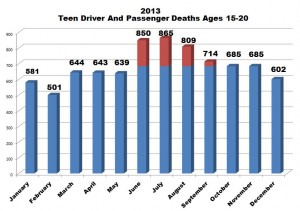Monthly Archives: May 2015

Self-Driving Car Wish List For Teens And Parents
May 11, 2015
When it comes to a wish list for self-driving cars, teens and parents share some ideas but differ widely on others. This not too surprising fact is the result of a study conducted by the Carnegie Mellon University School of Engineering (CMUSE).
CMUSE surveyed 1,000 people aged 18 – 70 on what types of features they thought should be included in self-driving cars. Parents, overwhelmingly wanted features to control their teen’s driving. Among the features parents wanted to see included in self-driving cars for teens were:
Controls to set speed limit, curfew time and number of passengers.
Eighty-four percent of respondents, including a majority of the youngest drivers, said their self-driving car wish list would include these features. Among the strongest advocates for these features are:
- People ages 66 to 70 – 91%
- Women – 87%
- People ages 18 to 24 – 81%
Controls to limit speed and the number of passengers could save countless lives among teen drivers. Excessive speed and driver distraction are among the top causes of crashes among teen drivers. Passengers are especially dangerous because they create a distracting environment for teen drivers and teen drivers tend to show off and take greater chances by speeding when they have peers as passengers. With the car controlling the speed, the teen driver can blame his slow driving on the car and still save face.
One might wonder why a limit on passengers would be necessary in a self-driving car. Most self driving cars, at least in the beginning, would still require a driver to be alert and take over in the event of a systems failure or where the computer fails to recognize a hazard. The more passengers there are, the more distractions there are for the driver and the greater the chance for a crash.
Curfew times are another good idea. Teens tend to be sleep deprived and falling asleep at the wheel is an all too common occurrence. A car that could keep a teen driver from staying out too late could also save a lot of lives and parent’s frayed nerves.
Control feature to limit the geographic range the car will travel.
Not surprisingly, this is a feature that most parents – men (62%) and women (61%) – want but the idea isn’t too popular among younger drivers with barely half (54%) thinking this feature is a good idea.
Parent text display to communicate with driver
This is another one of those wish list features that showed a large generational divide with 69% of the youngest drivers thinking it a good idea while only 53% of people aged 56 to 65 favored it. Women favored the idea (63%) more than men (57%). However, texting in any fashion whether using a hand-held cell phone or a built-in display screen, isn’t a good idea because it takes the driver’s eyes off the road for too long.
The need for and effectiveness of these wish list features will depend on just how completely autonomous the self-driving cars will be and how secure and hack-proof the control systems are.
Read more: Teens Probably Won’t Like Self-Driving Cars, But Their Parents Will

Teens Drive Better When Mom Comes Along
May 8, 2015
Teens drive better when mom comes along and they feel good about it too according to a study conducted by the Beckman Institute for Advanced Science and Technology, University of Illinois, Urbana – Champaign.
In this novel study, 25 fourteen year old teens were each placed in an fMRI machine that allowed the researchers to view and record their brain activity while driving a computer simulated driving course. The fMRI machine shows blood flow to areas of the brain that are most active. The teens were paid for their participation but they were also told that, if they scored the fastest time, they would get more money.
The course had 26 intersections and the timing of the lights and the presence of cross traffic varied so that the teens wouldn’t experience the same traffic patterns each time. If the teen stopped at a traffic light, it cost them three seconds added to their time. If they attempted to run a red light and were involved in a “crash,” it cost them 6 additional seconds.
When teens drove alone, they were much more likely to try to make it through a yellow light before it turned red. If they made it through safely, without costing them any more time, the researchers were able to see more blood flow to the reward center of the brain. In other words, the teens felt good about their decision and you could witness that good feeling as it appeared in the brain.
When the teens were told their mom was watching, the teens drove much more carefully and tended to stop when they encountered a yellow light. The strange thing is that, with mom “in the car,” the same reward area of the brain lit up when they drove safely.
It appears that, if a parent is along, teens tend to take fewer chances and they actually feel rewarded by driving in a safe manner.
Of course mom can’t be in the car at all times but there are systems that allow moms to look over their teen’s shoulder. There are a variety of apps and plug-in systems that report if the teen is driving aggressively, turn off the cell phone and inform the parents of the teen’s location. If only they could bake cookies too.
Read more: Having Mom in the Car Changes Teen Driver’s Brain

100 Deadliest Days For Teens
May 7, 2015
May is here and that means proms, graduations and the beginning of the 100 deadliest days for teens. Due to the above average number of teen driving deaths, the summer driving period – between Memorial Day and Labor Day – is historically known as the 100 deadliest days for teens.
In 2013, the last year for which there are figures, there was a monthly average of 685 teen drivers and passengers, aged 15 through 20, who lost their lives on US roadways. During the months of June through September, 498 additional teen drivers and passengers lost their lives in traffic crashes; an increase of 18.25% over the annual monthly average.
 What are the reasons for this increase in teen traffic deaths? Some of the reasons include:
What are the reasons for this increase in teen traffic deaths? Some of the reasons include:
- Lack of experience behind the wheel.
- Bored, unsupervised teens looking for excitement.
- Distracting passengers.
- Long, hot days on the beach or lake that can lead to dehydration and fatigue.
- Use of alcohol and drugs.
What can parents do to reduce this risk?
- Set limits for the number of passengers a teen can carry (this limit may already be set by law in your state).
- Set and enforce curfews.
- Keep your teen busy with chores or a summer job.
- Ban the use of cell phones and texting while driving.
- Avoid the temptation to check up on your teen by calling or texting while the teen may be driving. Instead, set a rule that the teen must call you upon arrival at a destination and upon departure.
- If necessary, use a smartphone app that can limit your teen’s cell phone use while driving along with tracking his or her whereabouts.
- Agree upon and sign a teen driving contract with your teen and enforce penalties for violations.
- If your teen is to be a passenger of another teen driver, know who that driver is and refuse permission if the teen is carrying too many passengers. Every teen passenger a teen driver carries increases the crash risk.
Don’t let your teen become a 100 deadliest days statistic.
